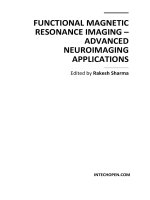DISCRETE WAVELET TRANSFORMS: ALGORITHMS AND APPLICATIONS Edited by Hannu Olkkonen pptx
Bạn đang xem bản rút gọn của tài liệu. Xem và tải ngay bản đầy đủ của tài liệu tại đây (20.26 MB, 308 trang )
DISCRETE WAVELET
TRANSFORMS:
ALGORITHMS AND
APPLICATIONS
Edited by Hannu Olkkonen
Discrete Wavelet Transforms: Algorithms and Applications
Edited by Hannu Olkkonen
Published by InTech
Janeza Trdine 9, 51000 Rijeka, Croatia
Copyright © 2011 InTech
All chapters are Open Access articles distributed under the Creative Commons
Non Commercial Share Alike Attribution 3.0 license, which permits to copy,
distribute, transmit, and adapt the work in any medium, so long as the original
work is properly cited. After this work has been published by InTech, authors
have the right to republish it, in whole or part, in any publication of which they
are the author, and to make other personal use of the work. Any republication,
referencing or personal use of the work must explicitly identify the original source.
Statements and opinions expressed in the chapters are these of the individual contributors
and not necessarily those of the editors or publisher. No responsibility is accepted
for the accuracy of information contained in the published articles. The publisher
assumes no responsibility for any damage or injury to persons or property arising out
of the use of any materials, instructions, methods or ideas contained in the book.
Publishing Process Manager Ivana Lorkovic
Technical Editor Teodora Smiljanic
Cover Designer Jan Hyrat
Image Copyright Scott Bowlin, 2010. Used under license from Shutterstock.com
First published August, 2011
Printed in Croatia
A free online edition of this book is available at www.intechopen.com
Additional hard copies can be obtained from
Discrete Wavelet Transforms: Algorithms and Applications, Edited by Hannu Olkkonen
p. cm.
ISBN 978-953-307-482-5
free online editions of InTech
Books and Journals can be found at
www.intechopen.com
Contents
Preface IX
Part 1 Discrete Wavelet Transform Based Hardware Algorithms 1
Chapter 1 Discrete Wavelet Multitone Modulation
for ADSL & Equalization Techniques 3
Sobia Baig, Fasih-ud-Din Farrukh and M. Junaid Mughal
Chapter 2 A Scalable Architecture for Discrete
Wavelet Transform on FPGA-Based System 25
Xun Zhang
Chapter 3 VLSI Architectures of Lifting-Based
Discrete Wavelet Transform 41
Sayed Ahmad Salehi and Rasoul Amirfattahi
Chapter 4 Simulation of Models and BER
Performances of DWT-OFDM versus FFT-OFDM 57
Khaizuran Abdullah and Zahir M. Hussain
Chapter 5 Several Kinds of Modified SPIHT Codec 67
Wenchao Zhang
Part 2 Image Processing Applications 79
Chapter 6 Multiresolution Approaches for Edge Detection and
Classification Based on Discrete Wavelet Transform 81
Guillermo Palacios, J. Ramón Beltrán and Raquel Lacuesta
Chapter 7 Low Bit Rate Video Compression Algorithm
Using 3-D Discrete Wavelet Decomposition 101
Awad Kh. Al-Asmari
Chapter 8 Low Complexity Implementation of Daubechies
Wavelets for Medical Imaging Applications 121
Khan Wahid
VI Contents
Chapter 9 Discrete Wavelets on Edges 135
Alexandre Chapiro, Tassio Knop De Castro,
Virginia Mota, Eder De Almeida Perez,
Marcelo Bernardes Vieira and Wilhelm Passarella Freire
Chapter 10 Discrete Wavelet Transform and Optimal Spectral
Transform Applied to Multicomponent Image Coding 151
Isidore Paul Akam Bita, Michel Barret, Florio Dalla Vedova,
Jean-Louis Gutzwiller and Dinh-Tuan Pham
Part 3 Discrete Wavelet Transforms for Watermaking 177
Chapter 11 Watermarking-Based Image Authentication
System in the Discrete Wavelet Transform Domain 179
Clara Cruz Ramos, Rogelio Reyes Reyes,
Mariko Nakano Miyatake and Héctor Manuel Pérez Meana
Chapter 12 Application of Discrete
Wavelet Transform in Watermarking 197
Corina Nafornita and Alexandru Isar
Part 4 Discrete Wavelet Transform Algorithms 219
Chapter 13 Shift Invariant Discrete Wavelet Transforms 221
Hannu Olkkonen and Juuso T. Olkkonen
Chapter 14 Condition on Word Length of Signals and
Coefficients for DC Lossless Property of DWT 231
Masahiro Iwahashi and Hitoshi Kiya
Chapter 15 Wavelet-Based Analysis and
Estimation of Colored Noise 255
Bart Goossens, Jan Aelterman, Hiêp Luong,
Aleksandra Pižurica and Wilfried Philips
Chapter 16 An Adaptive Energy Discretization
of the Neutron Transport Equation
Based on a Wavelet Galerkin Method 281
D. Fournier and R. Le Tellier
Preface
The discrete wavelet transform (DWT) algorithms have a firm position in processing
of signals in several areas of research and industry. As DWT provides both octave-
scale frequency and spatial timing of the analyzed signal, it is constantly used to solve
and treat more and more advanced problems. The DWT algorithms were initially
based on the compactly supported conjugate quadrature filters (CQFs). However, a
drawback in CQFs is due to the nonlinear phase effects such as spatial dislocations in
multi-scale analysis. This is avoided in biorthogonal discrete wavelet transform
(BDWT) algorithms, where the scaling and wavelet filters are symmetric and linear
phase. The BDWT algorithms are usually constructed by a ladder-type network called
lifting scheme. The procedure consists of sequential down and uplifting steps and the
reconstruction of the signal is made by running the lifting network in reverse order.
Efficient lifting BDWT structures have been developed for VLSI and microprocessor
applications. Only register shifts and summations are needed for integer arithmetic
implementation of the analysis and synthesis filters. In many systems BDWT-based
data and image processing tools have outperformed the conventional discrete cosine
transform (DCT) -based approaches. For example, in JPEG2000 Standard the DCT has
been replaced by the lifting BDWT.
A difficulty in multi-scale DWT analyses is the dependency of the total energy of the
wavelet coefficients in different scales on the fractional shifts of the analysed signal.
This has led to the development of the complex shift invariant DWT algorithms, the
real and imaginary parts of the complex wavelet coefficients are approximately a
Hilbert transform pair. The energy of the wavelet coefficients equals the envelope,
which provides shift-invariance. In two parallel CQF banks, which are constructed so
that the impulse responses of the scaling filters have half-sample delayed versions of
each other, the corresponding wavelet bases are a Hilbert transform pair. However,
the CQF wavelets do not have coefficient symmetry and the nonlinearity disturbs the
spatial timing in different scales and prevents accurate statistical analyses. Therefore
the current developments in theory and applications of shift invariant DWT
algorithms are concentrated on the dual-tree BDWT structures.
This book reviews the recent progress in discrete wavelet transform algorithms and
applications. The book covers a wide range of methods (e.g. lifting, shift invariance,
multi-scale analysis) for constructing DWTs. The book chapters are organized into
X Preface
four major parts. Part I describes the progress in hardware implementations of the
DWT algorithms. Applications include multitone modulation for ADSL and
equalization techniques, a scalable architecture for FPGA-implementation, lifting
based algorithm for VLSI implementation, comparison between DWT and FFT based
OFDM and modified SPIHT codec. Part II addresses image processing algorithms such
as multiresolution approach for edge detection, low bit rate image compression, low
complexity implementation of CQF wavelets and compression of multi-component
images. Part III focuses watermaking DWT algorithms. Finally, Part IV describes shift
invariant DWTs, DC lossless property, DWT based analysis and estimation of colored
noise and an application of the wavelet Galerkin method.
The chapters of the present book consist of both tutorial and highly advanced material.
Therefore, the book is intended to be a reference text for graduate students and
researchers to obtain state-of-the-art knowledge on specific applications. The editor is
greatly indebted to all co-authors for giving their valuable time and expertise in
constructing this book. The technical editors are also acknowledged for their tedious
support and help.
Hannu Olkkonen, Professor
University of Eastern Finland, Department of Applied Physics, Kuopio,
Finland
Part 1
Discrete Wavelet Transform Based
Hardware Algorithms
1
Discrete Wavelet Multitone Modulation for
ADSL & Equalization Techniques
Sobia Baig
1
, Fasih-ud-Din Farrukh
2
and M. Junaid Mughal
2
1
Electrical Engineering Department,
COMSATS Institute of Information Technology, Lahore
2
Faculty of Electronic Engineering,
GIK Institute of Engineering Sciences and Technology, Topi
1,2
Pakistan
1. Introduction
The reliable delivery of information over severe fading wireless or wired channels is a major
challenge in communication systems. At the heart of every communication system is the
physical layer, consisting of a transmitter, a channel and a receiver. A transmitter maps the
input digital information into a waveform suitable for transmission over the channel. The
communication channel distorts the transmitted waveform. One of the many sources of
signal distortion is the presence of multipath in the communication channel. Due to the
effect of the multipath signal propagation, inter-symbol interference (ISI) occurs in the
received waveform. Moreover, the transmitted signal gets distorted due to the effect of
various kinds of interference and noise, as it propagates through the channel. ISI and the
channel noise distort the amplitude and phase of the transmitted signal, which lead to
erroneous bit detection at the receiver. It is desirable for a good communication system that
its receiver is able to retrieve the digital information from the received waveform, even in
the presence of channel impairments such as, multipath effect and noise.
Orthogonal Frequency Division Multiplexing (OFDM) is a Multi-Carrier Modulation
(MCM) technique that enables high data rate transmission and is robust against ISI
(Saltzberg, 1967), (Weinstein and Ebert, 1971), (Hirosaki, 1981). It is a form of frequency
division multiplexing (FDM), where data is transmitted in several narrowband streams at
various carrier frequencies. The sub-carriers in an OFDM system are orthogonal under ideal
propagation conditions. By dividing the input bit-stream into multiple and parallel bit-
streams, the objective is to lower the data rate in each sub-channel as compared to the total
data rate and also to make sub-channel bandwidth lower than the coherence bandwidth of
the communication channel. Therefore, each sub-channel will experience flat-fading and will
have small ISI. Hence an OFDM system requires simplified equalization techniques, to
mitigate the inter-symbol interference. The ISI can be completely eliminated in OFDM
transceivers by utilizing the principle of cyclic prefixing (CP). Therefore, high data rate
communication systems prefer to apply multicarrier modulation techniques. OFDM has
been standardized for many digital communication systems, including ADSL, the 802.11a
and 802.11g Wireless LAN standards, Digital audio broadcasting including EUREKA 147
Discrete Wavelet Transforms: Algorithms and Applications
4
and Digital Radio Mondiale, Digital Video Broadcasting (DVB), some Ultra Wide Band
(UWB) systems, WiMax, and Power Line Communication (PLC) (Sari, et al., 1995)
(Frederiksen and Prasad, 2002), (Baig and Gohar, 2003).
Over the years, OFDM has evolved into variants, such as Discrete Multitone (DMT), and
hybrid modulation techniques, such as multi-carrier code division multiple access (MC-
CDMA), Wavelet OFDM and Discrete Wavelet Multitone (DWMT). Several factors are
responsible for the development of these variants, especially Wavelet based OFDM
techniques, which target several disadvantages associated with Multicarrier modulation
(MCM) techniques. Some of these drawbacks are:
the spectral inefficiency associated with the guard interval insertion, which includes the
cyclic prefix
the high degree of spectral leakage due to high magnitude side lobes of pulse shape of
sinusoidal carriers
OFDM based communication system’s sensitivity to inter-carrier interference (ICI) and
narrowband interference (NBI)
Therefore, a Discrete Wavelet Transform (DWT) based MCM system was developed as an
alternative to DFT based MCM scheme (Lindsey, 1995). DWT based MCM techniques came
to be known as Wavelet-OFDM in wireless communications and as Discrete Wavelet
Multitone (DWMT) for harsh and noisy wireline communication channels such as Digital
Subscriber Line (DSL) or Power Line Communications (PLC) (Baig and Mughal, 2009).
This chapter describes the application of DWT in Discrete Multitone (DMT) transceivers and
its performance analysis in Digital Subscriber Line (DSL) channel, in the presence of
background noise, crosstalk etc. Time domain equalization techniques proposed for DWT
based multitone that is DWMT are discussed, along with the simulation results. The pros
and cons of adopting DWT instead of DFT in DMT transceivers will also be discussed,
highlighting the open areas of research.
2. Basics of wavelet filter banks & multirate signal processing systems
Wavelets and filter banks play an important role in signal decomposition into various
subbands, signal analysis, modeling and reconstruction. Some areas of DSP, such as audio
and video compression, signal denoising, digital audio processing and adaptive filtering are
based on wavelets and multirate DSP systems. Digital communication is a relatively new
area for multirate DSP applications. The wavelets are implemented by utilizing multirate
filter banks (Fliege, 1994). The discovery of Quadrature Mirror Filter banks (QMF) led to the
idea of Perfect Reconstruction (PR), and thus to subband decomposition. Mallat came up
with the idea of implementing wavelets by filter banks for subband coding and
multiresolution decomposition (Mallat, 1999). DWT gives time-scale representation of a
digital signal using digital filtering techniques. The DWT analyzes the signal at different
frequency bands with different resolutions by decomposing the signal into approximation
and detail coefficients. The decomposition of the signal into different frequency bands is
obtained simply by successive high pass and low pass filtering of the time domain signal.
2.1 Analysis and synthesis filter banks
Analysis filter banks decomposes input signal into frequency subbands. A two channel
analysis filter bank, as shown in Fig. 1, splits the input signal ()into a high frequency
Discrete Wavelet Multitone Modulation for ADSL & Equalization Techniques
5
component
()and a low frequency component
(). The input signal () is passed
through a low pass filter
() and a high pass filter
(), yielding the
() and
()
respectively.
Fig. 1. Two-channel Analysis filter bank.
Consequently, with the sampling frequency,
=2, the available bandwidth from 0 to , is
divided into two halves, 0≤≤
4
for the lower frequency signal
()and
4
≤≤
2
for the high frequency signal
(). Therefore, the filtered signals
()and
(
)
have
half the bandwidth of the input signal after being convolved with the low pass filter and
high pass filter respectively.The filtered and downsampled signal spectra are shown in Fig.
2. In matrix form the sub-band signals are represented as (Fliege, 1994),
()
(),
=
(
)
(−
)
(
)
(−
)
(
)
(−
)
(1)
The two signal spectra overlap. The downsampling will produce aliased components of the
signals, that are functions of (−
/
) in Eq. 1, since the filtered signals are not bandlimited
to . Two-channel synthesis filter bank is the dual of analysis filter bank, as shown in Fig. 3.
() and
()denote the lowpass and highpass filters, which recombine the upsampled
signals
() and
() into (), the reconstructed version of the input signal. The aliased
images are removed by the filter
() in the frequency range
4
≤≤
2
, while the
filter
()eliminates the images in the upsampled signal
(
)
in the frequency range
0≤≤
4
. Therefore, the signal (), output from the synthesis filter bank is (Fliege,
1994),
(
)
=
(
)
(
)
(
)
(
)
(2)
Fig. 2. (Continued)
/2
Discrete Wavelet Transforms: Algorithms and Applications
6
Fig. 2. Signal spectra in two-channel analysis filter bank. (a) Low pass & high pass filter
transfer functions. (b) low pass filtered signal spectrum
().(c) high pass filtered signal
spectrum
(). (d) downsampled signal
()spectrum. (e) downsampled signal ()
spectrum (f) output signal spectra.
Fig. 3. Two-channel Synthesis filter bank.
2.2 Quadrature mirror filter bank
The analysis and the synthesis filter banks combine to form a structure commonly known as
the two-channel quadrature mirror filter (QMF) bank. QMF bank serves as the basic
/2
/2
/2
/2
2
2
Discrete Wavelet Multitone Modulation for ADSL & Equalization Techniques
7
building block in many multirate systems. A two-channel QMF bank is shown in Fig. 4. The
constituent analysis and synthesis filter banks have power complementary frequency
responses. The low pass and high pass filters in the analysis filter bank decompose the input
signal into sub-bands, and the decimation introduces a certain amount of aliasing, due to the
non-ideal frequency response of the analysis filters. However, the synthesis filters
characteristics are chosen with such frequency response, that the aliasing introduced by the
analysis filter bank is canceled out in the reconstruction process. The output signal
() is
the recovered version of the input signal (). Therefore, the output signal
() is
expressed as,
(
)
=
(
)
(
)
()
(−)
()
(−)
(
)
(
−
)
(3)
(
)
=
(
)
(
)
+
(
)
(−) (4)
The reconstructed signal
() consists of two terms, the first term that is the product of the
transfer function
(
)
and () is the desired QMF output, while the second term is the
product of the transfer function
(
)
and (−) is the aliasing term
(
)
denotes the
aliasing components produced by the overlapping frequency responses of the analysis and
synthesis filter banks. For an alias-free filter bank,
(
)
must be equal to zero. This
condition is mathematically expressed as (Vaidyanthan, 1993),
(
)
=
(
)
(
−
)
+
(
)
(−)
=0 (5)
This condition may be satisfied by choosing
(
)
=
(
−
)
and
(
)
=
(
−
)
, then the
desired QMF output is represented as (Fliege, 1994),
(
)
=
(
)
(
−
)
−
(
)
(−)
(6)
Fig. 4. Two-channel QMF bank.
The filter banks, which are able to perfectly reconstruct the input signal are the perfect
reconstruction filter banks, that satisfy the perfect reconstruction condition. The desired
QMF output includes the function
(
)
which gives perfect reconstruction of the input
signal if it is a mere delay, that is
(
)
=
(Fliege, 1994). Two-channel filter bank, shown
in Fig. 4, can be utilized to construct an octave-spaced wavelet filter bank with the help of a
tree type structure. Octave filter bank is constructed by the successive decomposition of the
low pass signal into constituent sub-bands, every time using the two-channel filter bank
(Qian, 2002). A three-level octave-spaced analysis filter bank is shown in Fig. 5 (a) and a
three-level octave-spaced synthesis filter bank is shown in Fig. 5 (b).
ˆ
()Xz
Discrete Wavelet Transforms: Algorithms and Applications
8
Fig. 5. (a) Three-level analysis filter bank (b) Three-level synthesis filter bank.
2.3 Transmultiplexer
Transmultiplexers form an integral part of modems and transceivers based on filter banks
that work on the principle of perfect reconstruction. A simple two-channel filter bank can be
utilized to illustrate the perfect reconstruction condition. A transmultiplexer is the dual of
Sub-band coder (SBC) in structure. Fig. 6 shows a two-channel transmultiplexer filter bank,
which converts a time-interleaved signal at its input to a FDM signal, having separate bands
of spectrum multiplexed together and then converts it back into TDM signal at its output.
Transmultiplexers find application in modems and transceivers for digital communication
(Vaidyanthan, 1993).
0
()
X
z
1
()
X
z
0
ˆ
()
X
z
1
ˆ
()
X
z
Fig. 6. Two-channel Transmultiplexer.
ˆ
x(n)
Discrete Wavelet Multitone Modulation for ADSL & Equalization Techniques
9
3. Discrete multitone modulation technique
Discrete Multitone (DMT) modulation is a variant of OFDM associated with various loading
algorithms, so as to optimize a transceiver’s performance in wireline channels like
Asymmetrical Digital Subscriber Line (ADSL) and power line (Chow, et al., 1991). In
literature, several loading algorithms have been developed; allocating resources such as data
bits, or power in order to optimize high data rate, low average transmitting power, or low
bit error rate. Typically two of these parameters are kept constant and third is the goal of
optimization.
A conventional DFT based DMT transceiver block diagram is shown in Fig. 7. The channel
bandwidth is divided into N sub-channels. The input serial bit-stream is also split into
parallel sub-streams. The data bits assigned to sub-channels are according to a loading
algorithm. For water-filling bit-loading algorithm, greater number of bits is assigned to
higher SNR sub-channels. If the value of SNR of a sub-channel is below a pre-assigned
threshold, then no bits are allocated to that sub-channel. The assigned bits are mapped onto
Quadrature amplitude modulation (QAM) constellation forming a complex symbol. The
QAM symbols are then modulated onto orthogonal sub-carriers using Inverse Fast Fourier
Transform (IFFT). The QAM symbols are duplicated with their conjugate symmetric
counterparts and subjected to 2 point IFFT, in order to generate real samples for
transmission through the channel. A DMT symbol is thus formulated.
A guard band consisting of a few samples of the DMT symbol is pre-appended to the
symbol. This is the cyclic prefix, which consists of the last v samples of the DMT symbol,
circularly wrapped to the 2 DMT symbol. The length of cyclic prefix is chosen such that
it will be longer than the length of the channel response. The cyclic prefix added to a DMT
symbol lengthens the symbol period, making it longer than the worst possible delay spread,
which is caused by time delayed reflections of the original symbol arriving at the receiver.
Consequently, the cyclic prefix serves the purpose of absorbing any multipath interference.
Due to this cyclic extended symbol, the samples required for performing the FFT can be
taken anywhere over the length of the symbol, without degradation by the neighboring
symbols. However, the information sent in the cyclic prefix is redundant and reduces the
transceiver throughput by (2+)/2. Between the transmitter and receiver lies the
communication channel, which introduces both noise and distortion (mainly due to
multipath propagation) to the composite transmit signal. The channel can be modeled as a
finite impulse response (FIR) filter that possesses a frequency-selective fading characteristic.
The cyclic prefixed signal is transmitted through the channel, the output of which gives the
product of the channel impulse response and the transmitted symbols in frequency domain.
DMT receiver is basically the dual of the DMT transmitter, with the exception of the
equalization part. The equalization block consists of two parts, the time-domain equalizer
(TEQ) and the frequency-domain equalizer (FEQ). The purpose of TEQ is channel-
shortening and it immediately follows the channel, as shown in the Fig. 7. It serves to
shorten the channel impulse response, so that the equalized channel impulse response is less
than the length of the cyclic prefix . At the receiver the cyclic prefix samples are discarded
and remaining samples are subject to Fast Fourier transform (FFT). The frequency domain
equalizer divides the received sub-symbols by the FFT coefficients of the shortened channel
impulse response. The resulting signal is demodulated to recover the original data bits and
converted into a serial bit stream.
Discrete Wavelet Transforms: Algorithms and Applications
10
Fig. 7. Functional block diagram of a DMT transceiver.
3.1 Evolution of discrete wavelet multitone modulation
A major drawback of DFT-DMT is that the rectangular low-pass prototype filter results in
sinc shaped sub-band spectral response, the first side lobes of which are only 13dB down, as
pointed out by Sandzberg (Sandzberg, 1995). A dispersive channel will thus introduce Inter-
Carrier Interference (ICI) at significant levels. To mitigate this we can increase filter bank
genus, and design sub-channels with greater spectral isolation. We call this a lapped
transform, and much work has been done on the particular case of the Lapped Orthogonal
Transform (LOT) (Malvar, 1992). General Extended Lapped Transform (ELT) design is
computationally prohibitive, however Cosine Modulated Filter Banks (CMFB) can be
efficiently implemented utilizing Discrete Cosine Transform (DCT). In this way the design
procedure is simplified if we allow the transmultiplexer filters to be modulated versions of a
low pass, linear-phase prototype. Therefore, instead of designing filters, we now only
design one prototype filter. Modulated filter banks implementing lapped transforms with
applications to communications are generally referred to as Discrete Wavelet Multitone
(DWMT), to distinguish from DMT which uses a rectangular prototype.
Many contributions in literature have emphasized the need for DWMT in specific channel
conditions. Tzannes and Proakis have proposed DWMT in (Tzannes, et al., 1994), and
shown it to be superior to DFT-DMT. Authors suggest implementing DWMT in DSL
channel for improved performance (Doux et al., 2003). Studies have compared DMT and
DWMT performance in DSL channel (Akansu and Xueming 1998).
DWT exhibits better spectral shaping compared to the rectangular shaped subcarriers of
OFDM. Therefore, it offers much lower side lobes in transmitted signal, which reduces its
sensitivity to narrowband interference (NBI) and inter-carrier interference (ICI). However, it
Discrete Wavelet Multitone Modulation for ADSL & Equalization Techniques
11
cannot utilize CP to mitigate ISI created by the frequency-selective channel, as various DWT
symbols overlap in time domain (Vaidyanathan, 1993). Nevertheless, such MCM systems
based on DWT require an efficient equalization technique to counter the ISI created by the
channel.
4. Discrete Wavelet Multitone (DWMT) in Digital Subscriber Line (DSL)
A system based on Discrete Wavelet Multitone (DWMT) for modulating and
demodulating the required signal using Discrete Wavelet Transform as a basis function
has been suggested in wireless applications (Jamin andMähönen, 2005). The importance of
DWMT in wireless communication is a recognized area of research and on similar lines a
DWMT system can be implemented in wireline communication. It can be used as a
maximally decimated filter bank with its overlapping symbols in time-domain. Therefore,
this structure does not require the addition of CP which is an overhead in DMT and
DWMT based wireline systems (Vaidyanathan, 1993). On the other hand, the wavelet
filters also possess the advantages of having greater side-lobe attenuation and requires no
CP (Bingham, 1990). Therefore, the DWMT systems are bandwidth efficient by not using
the CP which creates the problem of bandwidth containment in DMT based systems.
However, application of the DWMT systems in a dispersive channel like ADSL
necessitates a robust channel equalization technique (Sandberg and Tzannes, 1995). In
literature some equalization techniques for DMT based multicarrier systems have been
suggested by many authors (Pollet and Peeters, 2000); (Acker et al., 2001); (Acker et al.,
2004); (Karp et al.,2003) and DWMT based multicarrier systems (Viholainen et al., 1999).
Equalization is a key factor in the design of modems based on DWMT modulation
technique and till date, it remains an open research area. When using the Discrete Wavelet
Packet Transform (DWPT) as a basis function in DWMT systems, it is difficult to equalize
the overlapped symbols in time domain. We emphasize on the design of equalizer for
DWPT based DWMT multicarrier systems. The proposed system is based on DWPT for
DWMT wireline systems and time-domain equalization is suggested for the equalization
process of overlapped symbols.
In this chapter, the time-domain equalization through a linear transversal filter is applied.
The equalization algorithms are based on Zero-Forcing (Z-F) and minimum mean squared
error (MMSE) criterion to a discrete wavelet-packet transform based DWMT transceiver for
a wireline ADSL channel. It is then compared with the system’s performance of a DMT
based ADSL system. For a fair comparison between the two systems, the DMT system also
utilizes the same time-domain equalization. The performance of the proposed wavelet-
packet based transceiver is also evaluated in the presence of near-end crosstalk (NEXT) and
far-end crosstalk (FEXT) for downstream ADSL. It is shown that the DWMT system
conserves precious bandwidth by not utilizing any CP, and gives improvement in bit error
rate (BER) performance over the DMT system with time-domain equalization (TEQ).
4.1 System model of DWMT
The DWMT system model’s block diagram is shown in Fig. 8. It divides the input data bit-
stream into multiple and parallel bit-streams. The proposed DWMT transceiver is based on
discrete wavelet packet transform (DWPT). The DWPT is implemented through a reverse
order perfect reconstruction filter bank transmultiplexer. Wavelet packets can be
Discrete Wavelet Transforms: Algorithms and Applications
12
implemented as a set of FIR filters, which leads to the filter bank realization of wavelet
transform, according to Mallat’s algorithm (Mallat, 1998). The blocked version of the input
signal
() is mapped to a variable QAM constellation according to the number of bits
loaded. This is interpolated and filtered by the
branch synthesis filter
().The
combined signal is sent through the channel, and the received signal is filtered by an
equalizer filter. The equalized signal is passed through the corresponding analysis filter
() and decimated to retrieve the QAM encoded version of the transmitted signal. The
transmitted signal is recovered after QAM decoding.
Fig. 8. Functional Block diagram of DWMT system.
4.1.1 Water filling bit loading
Bit loading is usually applied to DMT modulated systems applied to wireline channels, by
first estimating the signal-to-noise ratio (SNR) of each sub-channel through channel
estimation techniques, which is followed by the distribution of bits to these sub-channels
according to their respective SNR. Water-Filling bit loading algorithm applied in the
proposed system is rate adaptive and it is suitable for achieving maximum bit rate and also
useful when considering the large number of sub-channels and variable QAM constellation
(Leke and Cioffi, 1997);(Yu and Cioffi, 2001). A discrete version of this algorithm is applied,
in which the bit-loading procedure initiates by determining the sub-channels that should be
turned off, due to very low SNR. The bits are assigned to channels according to their
capacity, expressed mathematically as (Thomas et al., 2002),
2
1
log 1
2.
m
SNR
b
(7)
where SNR = ε
n
.g
n
is the SNR of each sub-channel, ε
n
is the sub-channel energy and g
n
is the
sub-channel SNR and it can be calculated as,
2
2
n
n
H
g
(8)
where H
n
is the ADSL channel impulse response and σ
2
is the noise power, Γ is the SNR gap
and γ
m
is the performance margin, which is the amount by which SNR can be reduced (Yu
and Cioffi,2001). The water filling bit-loading for the proposed system is shown in Fig. 9.
While considering the DWMT based communication system for the ADSL channel, it is
necessary to consider its frequency response and the effect of crosstalk, near-end crosstalk
(NEXT), and far-end crosstalk (FEXT) in system simulation. The ADSL channel impairments
and crosstalk is briefly discussed in the following section.
Discrete Wavelet Multitone Modulation for ADSL & Equalization Techniques
13
Fig. 9. ADSL channel frequency response & number of bits loaded according to discrete
water-filling algorithm.
4.2 ADSL channel
Digital Subscriber Line, commonly known as DSL is the most popular and ubiquitously
available wireline medium which provides high-speed Internet access over the twisted pair
telephone network. Fig. 10 shows a typical DSL network, which consists of copper lines
extending all the way from the central office (CO) to the customer’s premises. Current and
future applications such as Interactive Personalized TV, high definition TV (HDTV) and
video-on-demand through high-speed Internet access, will require more bandwidth.
Researchers are exploring cost-effective ways to exploit the existing copper infrastructure to
deliver greater bandwidth.
Fig. 10. A typical DSL network connecting subscribers to internet services through DSL to
the Central Office.
Although the DSL channel offers the advantage of utilizing the already in place telephone
lines to carry digital data, however there are different channel impairments that pose









